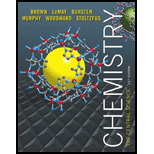
Chemistry: The Central Science (13th Edition)
13th Edition
ISBN: 9780321910417
Author: Theodore E. Brown, H. Eugene LeMay, Bruce E. Bursten, Catherine Murphy, Patrick Woodward, Matthew E. Stoltzfus
Publisher: PEARSON
expand_more
expand_more
format_list_bulleted
Textbook Question
Chapter 19, Problem 66E
From the values given for ΔH° and ΔS°, calculate ΔG° for each of the following reactions at 298 K. If the reaction is not spontaneous under standard conditions at 298 K, at what temperature (if any) would the reaction become spontaneous?
- 2PbS(s) + 3O2(g) → 2 PbO(s) + 2SO2(s) ΔH° = -844 kJ; ΔS° = -165 J/K
Expert Solution & Answer
Want to see the full answer?
Check out a sample textbook solution
Chapter 19 Solutions
Chemistry: The Central Science (13th Edition)
Ch. 19.1 - The process of iron being oxidized to make...Ch. 19.1 - Prob. 19.1.2PECh. 19.2 - Do all exothermic phase changes have a negative...Ch. 19.2 - Prob. 19.2.2PECh. 19.3 - Prob. 19.3.1PECh. 19.3 - Prob. 19.3.2PECh. 19.3 - Suppose you have two 1-L flasks, one containing N2...Ch. 19.3 - Prob. 19.4.2PECh. 19.4 -
10.8
Place the following gases in order of...Ch. 19.4 - Prob. 19.5.2PE
Ch. 19.5 - Prob. 19.6.1PECh. 19.5 - Prob. 19.6.2PECh. 19.5 - Prob. 19.7.1PECh. 19.5 - Prob. 19.7.2PECh. 19.5 - Prob. 19.8.1PECh. 19.5 - Prob. 19.8.2PECh. 19.6 - Prob. 19.9.1PECh. 19.6 - Prob. 19.9.2PECh. 19.7 - Prob. 19.10.1PECh. 19.7 - Prob. 19.10.2PECh. 19.7 - Prob. 19.11.1PECh. 19.7 - Prob. 19.11.2PECh. 19.7 - Prob. 19.12.1PECh. 19.7 - Prob. 19.12.2PECh. 19 - Prob. 1DECh. 19 - Prob. 1ECh. 19 - Prob. 2ECh. 19 - Prob. 3ECh. 19 - Prob. 4ECh. 19 - Prob. 5ECh. 19 - Prob. 6ECh. 19 - 11.47 Indicate whether each statement is true or...Ch. 19 - Prob. 8ECh. 19 - Prob. 9ECh. 19 - Prob. 10ECh. 19 - Prob. 11ECh. 19 - Prob. 12ECh. 19 - Prob. 13ECh. 19 - Prob. 14ECh. 19 - A glass vessel fitted with a stopcock valve has a...Ch. 19 - Prob. 16ECh. 19 - Prob. 17ECh. 19 - Prob. 18ECh. 19 - Prob. 19ECh. 19 - Prob. 20ECh. 19 - Prob. 21ECh. 19 - Consider what happens when a sample of the...Ch. 19 - Prob. 23ECh. 19 - Prob. 24ECh. 19 - The normal boiling point of Br2(l) is 58.8 °C, and...Ch. 19 - Prob. 26ECh. 19 - Prob. 27ECh. 19 - Prob. 28ECh. 19 - Prob. 29ECh. 19 - Prob. 30ECh. 19 - Prob. 31ECh. 19 - Prob. 32ECh. 19 - Prob. 33ECh. 19 - Prob. 34ECh. 19 - 19.35 (a) What do you expect for the sign of ∆S in...Ch. 19 - Prob. 36ECh. 19 - Prob. 37ECh. 19 - Prob. 38ECh. 19 - Prob. 39ECh. 19 - Prob. 40ECh. 19 - For each of the fallowing pairs, choose the...Ch. 19 - Prob. 42ECh. 19 - Prob. 43ECh. 19 - Prob. 44ECh. 19 - Prob. 45ECh. 19 - Prob. 46ECh. 19 - Prob. 47ECh. 19 - Cyclopropane and propylene are isomers that both...Ch. 19 - Prob. 49ECh. 19 - Prob. 50ECh. 19 - Prob. 51ECh. 19 - Prob. 52ECh. 19 - Prob. 53ECh. 19 - Prob. 54ECh. 19 - Prob. 55ECh. 19 - Prob. 56ECh. 19 - Prob. 57ECh. 19 - Prob. 58ECh. 19 - Using data in Appendix C, calculate HO, SO,...Ch. 19 - Prob. 60ECh. 19 - Prob. 61ECh. 19 - Prob. 62ECh. 19 - Prob. 63ECh. 19 - Prob. 64ECh. 19 - Prob. 65ECh. 19 - From the values given for H° and S°, calculate G°...Ch. 19 - Prob. 67ECh. 19 - Prob. 68ECh. 19 - Prob. 69ECh. 19 - Prob. 70ECh. 19 - Prob. 71ECh. 19 - Prob. 72ECh. 19 - (a) Use data in Appendix C to estimate the boiling...Ch. 19 - Prob. 74ECh. 19 - Prob. 75ECh. 19 - Prob. 76ECh. 19 - Prob. 77ECh. 19 - Prob. 78ECh. 19 - Consider the reaction 2 NO2(g) (N2O4(g). (a)...Ch. 19 - Prob. 80ECh. 19 - Prob. 81ECh. 19 - Prob. 82ECh. 19 - Prob. 83ECh. 19 - Prob. 84ECh. 19 - Prob. 85ECh. 19 - The Kb, for methylamine (CH3NH2) at 25oC is given...Ch. 19 - Prob. 87AECh. 19 - Prob. 88AECh. 19 - Prob. 89AECh. 19 - Prob. 90AECh. 19 - Prob. 91AECh. 19 - Prob. 92AECh. 19 - Prob. 93AECh. 19 - Prob. 94AECh. 19 - Prob. 95AECh. 19 - Prob. 96AECh. 19 - Consider the following three reactions: (i) Ti (s)...Ch. 19 - Prob. 98AECh. 19 - (a) For each of the following reactions, predict...Ch. 19 - Prob. 100AECh. 19 - Prob. 101AECh. 19 - Prob. 102AECh. 19 - Prob. 103AECh. 19 - Prob. 104AECh. 19 - Prob. 105AECh. 19 - Prob. 106AECh. 19 - Most liquids follow Trouton’s rule (see Exercise...Ch. 19 - 19.108 In chemical kinetics the entropy of...Ch. 19 - Prob. 109IECh. 19 - Prob. 110IECh. 19 - Prob. 111IECh. 19 - Prob. 112IECh. 19 - The following data compare the standard enthalpies...Ch. 19 - Prob. 114IECh. 19 - Prob. 115IECh. 19 - Prob. 116IE
Knowledge Booster
Learn more about
Need a deep-dive on the concept behind this application? Look no further. Learn more about this topic, chemistry and related others by exploring similar questions and additional content below.Similar questions
- Consider the reaction of 2 mol H2(g) at 25C and 1 atm with 1 mol O2(g) at the same temperature and pressure to produce liquid water at these conditions. If this reaction is run in a controlled way to generate work, what is the maximum useful work that can be obtained? How much entropy is produced in this case?arrow_forwardWhat is the sign of the standard Gibbs free-energy change at low temperatures and at high temperatures for the explosive decomposition of TNT? Use your knowledge of TNT and the chemical equation, particularly the phases, to answer this question. (Thermodynamic data for TNT are not in Appendix G.) 2C7H5N3O6(s) 3N2(g) + 5H2O() + 7C(s) + 7CO(g)arrow_forwardAt 298 K, G = 70.52 kJ for the reaction 2NO(g) + O2(g) 2NO2(g) (a) Calculate _G at the same temperature when PNO = 1.0 104 atm, PO2=2.0103 atm, and PNO2=0.30 atm. (b) Under the conditions in part a, in which direction is the reaction spontaneous?arrow_forward
- Consider the reaction of 1 mol H2(g) at 25C and 1 atm with 1 mol Br2(l) at the same temperature and pressure to produce gaseous HBr at these conditions. If this reaction is run in a controlled way to generate work, what is the maximum useful work that can be obtained? How much entropy is produced in this case?arrow_forwardOne of the important reactions in the biochemical pathway glycolysis is the reaction of glucose-6-phosphate (G6P) to form fructose-6-phosphate (F6P): G6PF6PG298=1.7kJ (a) Is the reaction spontaneous or nonspontaneous under standard thermodynamic conditions?. (b) Standard thermodynamic conditions imply the concentrations of G6P and F6P to be 1 M, however, in a typical cell, they are not even Close to these values. Calculate G when the concentrations of G6P and F6P are 120 M and 28 M respectively, and discuss the spontaneity of the forward reaction under these conditions. Assume the temperature is 37 C.arrow_forwardWhat is the sign of the standard Gibbs free-energy change at low temperatures and at high temperatures for the synthesis of ammonia? 3H2(g) + N2(g) 2NH3(g)arrow_forward
- On the basis of your experience, predict which reactions are spontaneous: (a) PbO2(s)Pb(s)+O2(g)(b) N2(l)N2(g) at 25C (c) C6H12O6(s)C6H12O6(l) at 25C (d) Ca2+(aq)+CO32(aq)CaCO3(s)arrow_forwardUse S values to calculate the standard entropy change, rS0, for each of the following processes and comment on the sign of the change. (a) KOH(s) KOH(aq) (b) Na(g) Na(s) (c) Br2() Br2(g) (d) HCl(g) HCl(aq)arrow_forwardEstimate the temperature range over which each of the following reactions is spontaneous. (a) 2Al(s)+3Cl2(g)2AlCl3(s) (b) 2NOCl(g)2NO(g)+Cl2(g) (c) 4NO(g)+6H2O(g)4NH3(g)+5O2(g) (d) 2PH3(g)3H2(g)+2P(g)arrow_forward
- For each of the following processes, identify the systemand the surroundings. Identify those processes that arespontaneous. For each spontaneous process, identify theconstraint that has been removed to enable the process to occur: Ammonium nitrate dissolves in water. Hydrogen and oxygen explode in a closed bomb. A rubber band is rapidly extended by a hangingweight. The gas in a chamber is slowly compressed by aweighted piston. A glass shatters on the floor.arrow_forwardConsider the decomposition of red mercury(II) oxide under standard state conditions.. 2HgO(s,red)2Hg(l)+O2(g) (a) Is the decomposition spontaneous under standard state conditions? (b) Above what temperature does the reaction become spontaneous?arrow_forward
arrow_back_ios
arrow_forward_ios
Recommended textbooks for you
 Chemistry by OpenStax (2015-05-04)ChemistryISBN:9781938168390Author:Klaus Theopold, Richard H Langley, Paul Flowers, William R. Robinson, Mark BlaserPublisher:OpenStax
Chemistry by OpenStax (2015-05-04)ChemistryISBN:9781938168390Author:Klaus Theopold, Richard H Langley, Paul Flowers, William R. Robinson, Mark BlaserPublisher:OpenStax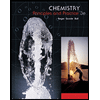 Chemistry: Principles and PracticeChemistryISBN:9780534420123Author:Daniel L. Reger, Scott R. Goode, David W. Ball, Edward MercerPublisher:Cengage Learning
Chemistry: Principles and PracticeChemistryISBN:9780534420123Author:Daniel L. Reger, Scott R. Goode, David W. Ball, Edward MercerPublisher:Cengage Learning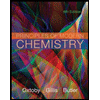 Principles of Modern ChemistryChemistryISBN:9781305079113Author:David W. Oxtoby, H. Pat Gillis, Laurie J. ButlerPublisher:Cengage Learning
Principles of Modern ChemistryChemistryISBN:9781305079113Author:David W. Oxtoby, H. Pat Gillis, Laurie J. ButlerPublisher:Cengage Learning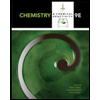 Chemistry & Chemical ReactivityChemistryISBN:9781133949640Author:John C. Kotz, Paul M. Treichel, John Townsend, David TreichelPublisher:Cengage Learning
Chemistry & Chemical ReactivityChemistryISBN:9781133949640Author:John C. Kotz, Paul M. Treichel, John Townsend, David TreichelPublisher:Cengage Learning Chemistry & Chemical ReactivityChemistryISBN:9781337399074Author:John C. Kotz, Paul M. Treichel, John Townsend, David TreichelPublisher:Cengage Learning
Chemistry & Chemical ReactivityChemistryISBN:9781337399074Author:John C. Kotz, Paul M. Treichel, John Townsend, David TreichelPublisher:Cengage Learning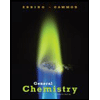 General Chemistry - Standalone book (MindTap Cour...ChemistryISBN:9781305580343Author:Steven D. Gammon, Ebbing, Darrell Ebbing, Steven D., Darrell; Gammon, Darrell Ebbing; Steven D. Gammon, Darrell D.; Gammon, Ebbing; Steven D. Gammon; DarrellPublisher:Cengage Learning
General Chemistry - Standalone book (MindTap Cour...ChemistryISBN:9781305580343Author:Steven D. Gammon, Ebbing, Darrell Ebbing, Steven D., Darrell; Gammon, Darrell Ebbing; Steven D. Gammon, Darrell D.; Gammon, Ebbing; Steven D. Gammon; DarrellPublisher:Cengage Learning

Chemistry by OpenStax (2015-05-04)
Chemistry
ISBN:9781938168390
Author:Klaus Theopold, Richard H Langley, Paul Flowers, William R. Robinson, Mark Blaser
Publisher:OpenStax

Chemistry: Principles and Practice
Chemistry
ISBN:9780534420123
Author:Daniel L. Reger, Scott R. Goode, David W. Ball, Edward Mercer
Publisher:Cengage Learning

Principles of Modern Chemistry
Chemistry
ISBN:9781305079113
Author:David W. Oxtoby, H. Pat Gillis, Laurie J. Butler
Publisher:Cengage Learning

Chemistry & Chemical Reactivity
Chemistry
ISBN:9781133949640
Author:John C. Kotz, Paul M. Treichel, John Townsend, David Treichel
Publisher:Cengage Learning

Chemistry & Chemical Reactivity
Chemistry
ISBN:9781337399074
Author:John C. Kotz, Paul M. Treichel, John Townsend, David Treichel
Publisher:Cengage Learning

General Chemistry - Standalone book (MindTap Cour...
Chemistry
ISBN:9781305580343
Author:Steven D. Gammon, Ebbing, Darrell Ebbing, Steven D., Darrell; Gammon, Darrell Ebbing; Steven D. Gammon, Darrell D.; Gammon, Ebbing; Steven D. Gammon; Darrell
Publisher:Cengage Learning
The Laws of Thermodynamics, Entropy, and Gibbs Free Energy; Author: Professor Dave Explains;https://www.youtube.com/watch?v=8N1BxHgsoOw;License: Standard YouTube License, CC-BY